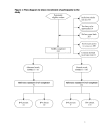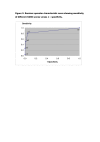The sensitivity and specificity of four questions (HARK) to identify intimate partner violence: a diagnostic accuracy study in general practice
- PMID: 17727730
- PMCID: PMC2034562
- DOI: 10.1186/1471-2296-8-49
The sensitivity and specificity of four questions (HARK) to identify intimate partner violence: a diagnostic accuracy study in general practice
Abstract
Background: Intimate partner violence (IPV) including physical, sexual and emotional violence, causes short and long term ill-health. Brief questions that reliably identify women experiencing IPV who present in clinical settings are a pre-requisite for an appropriate response from health services to this substantial public health problem. We estimated the sensitivity and specificity of four questions (HARK) developed from the Abuse Assessment screen, compared to a 30-item abuse questionnaire, the Composite Abuse Scale (CAS).
Methods: We administered the four HARK questions and the CAS to women approached by two researchers in general practice waiting rooms in Newham, east London. Inclusions: women aged more than 17 years waiting to see a doctor or nurse, who had been in an intimate relationship in the last year.
Exclusions: women who were accompanied by children over four years of age or another adult, too unwell to complete the questionnaires, unable to understand English or unable to give informed consent.
Results: Two hundred and thirty two women were recruited. The response rate was 54%. The prevalence of current intimate partner violence, within the last 12 months, using the CAS cut off score of >or=3, was 23% (95% C.I. 17% to 28%) with pre-test odds of 0.3 (95% C.I. 0.2 to 0.4). The receiver operator characteristic curve demonstrated that a HARK cut off score of >or=1 maximises the true positives whilst minimising the false positives. The sensitivity of the optimal HARK cut-off score of >or=1 was 81% (95% C.I. 69% to 90%), specificity 95% (95% C.I. 91% to 98%), positive predictive value 83% (95% C.I. 70% to 91%), negative predictive value 94% (95% C.I. 90% to 97%), likelihood ratio 16 (95% C.I. 8 to 31) and post-test odds 5.
Conclusion: The four HARK questions accurately identify women experiencing IPV in the past year and may help women disclose abuse in general practice. The HARK questions could be incorporated into the electronic medical record in primary care to prompt clinicians to ask about recent partner violence and to encourage disclosure by patients. Future research should test the effectiveness of HARK in clinical consultations.
Figures
Similar articles
-
Screening for intimate partner violence in orthopedic patients: a comparison of three screening tools.J Interpers Violence. 2012 Mar;27(5):881-98. doi: 10.1177/0886260511423246. Epub 2011 Oct 10. J Interpers Violence. 2012. PMID: 21987513
-
Intimate partner violence and help-seeking--a cross-sectional study of women in Sweden.BMC Public Health. 2013 Sep 21;13:866. doi: 10.1186/1471-2458-13-866. BMC Public Health. 2013. PMID: 24053735 Free PMC article.
-
Clinical utility of an intimate partner violence screening tool for female VHA patients.J Gen Intern Med. 2013 Oct;28(10):1288-93. doi: 10.1007/s11606-013-2534-x. Epub 2013 Jul 4. J Gen Intern Med. 2013. PMID: 23824907 Free PMC article.
-
Screening for intimate partner violence within a health care setting:a systematic review of the literature.Soc Work Health Care. 2007;45(1):1-18. doi: 10.1300/J010v45n01_01. Soc Work Health Care. 2007. PMID: 17804344
-
Intimate partner violence and health: a critique of Canadian prevalence studies.Can J Public Health. 2003 Jan-Feb;94(1):52-8. doi: 10.1007/BF03405053. Can J Public Health. 2003. PMID: 12583680 Free PMC article. Review.
Cited by
-
Improving the healthcare response to domestic violence and abuse in UK primary care: interrupted time series evaluation of a system-level training and support programme.BMC Med. 2020 Mar 5;18(1):48. doi: 10.1186/s12916-020-1506-3. BMC Med. 2020. PMID: 32131828 Free PMC article.
-
Depressive and anxiety symptoms and COVID-19-related factors among men and women in Nigeria.PLoS One. 2021 Aug 26;16(8):e0256690. doi: 10.1371/journal.pone.0256690. eCollection 2021. PLoS One. 2021. PMID: 34437601 Free PMC article.
-
Perceptions of firearms in a cohort of women exposed to intimate partner violence (IPV) in Central Pennsylvania.BMC Womens Health. 2021 Jan 8;21(1):20. doi: 10.1186/s12905-020-01134-y. BMC Womens Health. 2021. PMID: 33419432 Free PMC article.
-
A pilot cluster randomized controlled trial assessing uptake of PrEP and contraception in hair salons in South Africa.BMC Public Health. 2025 Feb 8;25(1):524. doi: 10.1186/s12889-025-21718-3. BMC Public Health. 2025. PMID: 39922997 Free PMC article. Clinical Trial.
-
Clinical and psychosocial factors associated with domestic violence among men and women in Kandy, Sri Lanka.PLOS Glob Public Health. 2022 Apr 1;2(4):e0000129. doi: 10.1371/journal.pgph.0000129. eCollection 2022. PLOS Glob Public Health. 2022. PMID: 36962126 Free PMC article.
References
-
- WHO multi-country study on women's health and domestic violence against women: summary report of initial results on prevalence, health outcomes and women's responses. Geneva, World Health Organization; 2005.
-
- Hegarty K. What is intimate partner abuse and how common is it? In: Roberts G, Hegarty K, Feder G, editor. Intimate partner abuse and health professionals – new approaches to domestic violence. London; Churchill Livingstone Elsevier; 2006. pp. 32–35.
Publication types
MeSH terms
LinkOut - more resources
Full Text Sources
Miscellaneous



